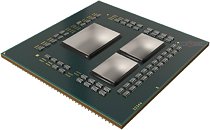- Joined
- Oct 9, 2007
- Messages
- 47,448 (7.50/day)
- Location
- Hyderabad, India
| System Name | RBMK-1000 |
|---|---|
| Processor | AMD Ryzen 7 5700G |
| Motherboard | ASUS ROG Strix B450-E Gaming |
| Cooling | DeepCool Gammax L240 V2 |
| Memory | 2x 8GB G.Skill Sniper X |
| Video Card(s) | Palit GeForce RTX 2080 SUPER GameRock |
| Storage | Western Digital Black NVMe 512GB |
| Display(s) | BenQ 1440p 60 Hz 27-inch |
| Case | Corsair Carbide 100R |
| Audio Device(s) | ASUS SupremeFX S1220A |
| Power Supply | Cooler Master MWE Gold 650W |
| Mouse | ASUS ROG Strix Impact |
| Keyboard | Gamdias Hermes E2 |
| Software | Windows 11 Pro |
AMD's 3rd generation Ryzen (3000-series) processors will overcome a vast number of memory limitations faced by older Ryzen chips. With Zen 2, the company decided to separate the memory controller from the CPU cores into a separate chip, called "IO die". Our resident Ryzen memory guru Yuri "1usmus" Bubliy, author of DRAM Calculator for Ryzen, found technical info that confirms just how much progress AMD has been making.
The third generation Ryzen processors will be able to match their Intel counterparts when it comes to memory overclocking. In the Zen 2 BIOS, the memory frequency options go all the way up to "DDR4-5000", which is a huge increase over the first Ryzens. The DRAM clock is still linked to the Infinity Fabric (IF) clock domain, which means at DDR4-5000, Infinity Fabric would tick at 5000 MHz DDR, too. Since that rate is out of reach for IF, AMD has decided to add a new 1/2 divider mode for their on-chip bus. When enabled, it will run Infinity Fabric at half the DRAM actual clock (eg: 1250 MHz for DDR4-5000).

This could turn into an additional selling point for AMD X570 chipset motherboards, as they'll have a memory frequency headroom advantage over boards based on older chipsets as their BIOS will include not just the increased memory clock limit, but also the divider mode. Of course this doesn't mean that you can just magically overclock any memory kit to these 5 GHz speeds - it's probable that only the best of the best modules will be able to get close to these speeds.
1usmus also discovered that the platform adds a SoC OC mode and VDDG voltage control. We've heard from several sources that AMD invested heavily in improving memory compatibility, especially in the wake of Samsung discontinuing its B-die DRAM chips.
View at TechPowerUp Main Site
The third generation Ryzen processors will be able to match their Intel counterparts when it comes to memory overclocking. In the Zen 2 BIOS, the memory frequency options go all the way up to "DDR4-5000", which is a huge increase over the first Ryzens. The DRAM clock is still linked to the Infinity Fabric (IF) clock domain, which means at DDR4-5000, Infinity Fabric would tick at 5000 MHz DDR, too. Since that rate is out of reach for IF, AMD has decided to add a new 1/2 divider mode for their on-chip bus. When enabled, it will run Infinity Fabric at half the DRAM actual clock (eg: 1250 MHz for DDR4-5000).

This could turn into an additional selling point for AMD X570 chipset motherboards, as they'll have a memory frequency headroom advantage over boards based on older chipsets as their BIOS will include not just the increased memory clock limit, but also the divider mode. Of course this doesn't mean that you can just magically overclock any memory kit to these 5 GHz speeds - it's probable that only the best of the best modules will be able to get close to these speeds.
1usmus also discovered that the platform adds a SoC OC mode and VDDG voltage control. We've heard from several sources that AMD invested heavily in improving memory compatibility, especially in the wake of Samsung discontinuing its B-die DRAM chips.
View at TechPowerUp Main Site







